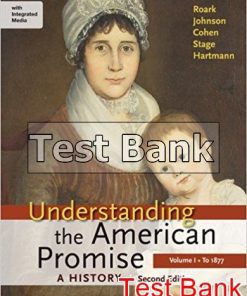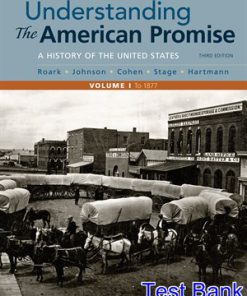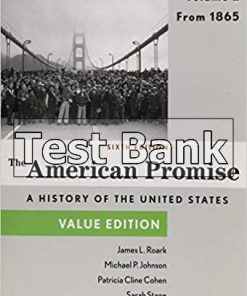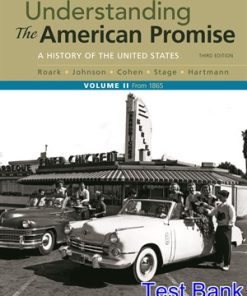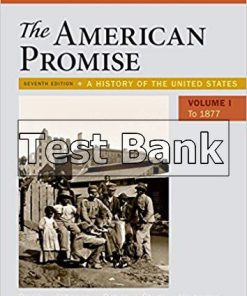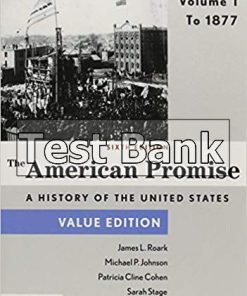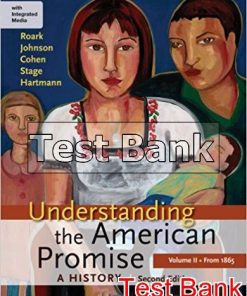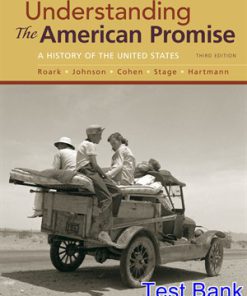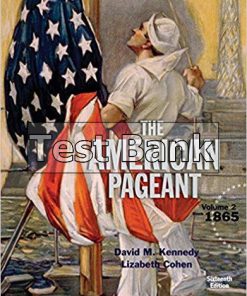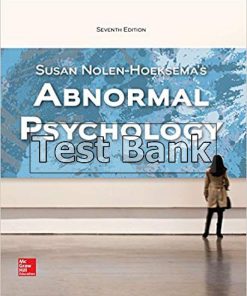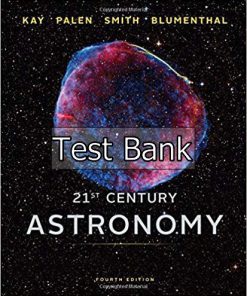American Promise Value Volume 2 7th Edition Roark Test Bank
$50.00 Original price was: $50.00.$26.50Current price is: $26.50.
American Promise Value Volume 2 7th Edition Roark Test Bank.
This is completed downloadable of American Promise Value Volume 2 7th Edition Roark Test Bank
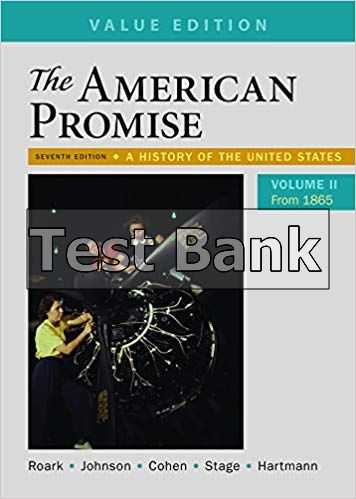
Product Details:
- ISBN-10 : 1319062008
- ISBN-13 : 978-1319062002
- Author: James L. Roark (Author), Michael P. Johnson (Author), Patricia Cline Cohen (Author), Sarah Stage (Author), Susan M. Hartmann (Author)
An affordable and compact text, American Promise, Value Edition, Volume 2 takes you through history with an easily-accessible style, sensible chronology, and commentary from ordinary Americans.
Table of Content:
Please Note: The Combined Volume includes all chapters. Volume 1 includes Chapters 1-16 and Volume 2 includes Chapters 16-31.
NOTE: LaunchPad material that does not appear in the print book – including guided reading exercises, source feature quizzes, LearningCurve adaptive quizzes, summative quizzes, and all of the documents from the companion reader Reading the American Past – has been labeled on this table of contents as shown. Each chapter in LaunchPad also comes with a wealth of additional documents, videos, key terms flashcards, map quizzes, timeline activities, and much more, all of which can be easily integrated and assigned.
Preface
Versions and Supplements
Maps, Figures, and Tables
Special Features
Chapter 16 Summative Quiz LaunchPad
Documents from Reading the American Past, Chapter 16
Document 16-1: Carl Schurz Reports on the Condition of the Defeated South: Report on the Condition of the South, 1865
Quiz for Document 16-1: Carl Schurz Reports on the Condition of the Defeated South: Report on the Condition of the South, 1865 LaunchPad
Document 16-2: Black Codes Enacted in the South: Mississippi Black Code, November 1865
Quiz for Document 16-2: Black Codes Enacted in the South: Mississippi Black Code, November 1865 LaunchPad
Document 16-3: Former Slaves Seek to Reunite Their Families: Advertisements from the Christian Recorder, 1865-1870
Quiz for Document 16-3: Former Slaves Seek to Reunite Their Families: Advertisements from the Christian Recorder, 1865-1870 LaunchPad
Document 16-4: Planter Louis Manigault Visits His Plantations and Former Slaves, 1867: Louis Manigault, “A Narrative of a Post-Civil War Visit to Gowrie and East Hermitage Plantations,” March 22, 1867
Quiz for Document 16-4: Planter Louis Manigault Visits His Plantations and Former Slaves, 1867: Louis Manigault, “A Narrative of a Post-Civil War Visit to Gowrie and East Hermitage Plantations,” March 22, 1867 LaunchPad
Document 16-5: Klan Violence against Blacks: Elias Hill, Testimony before Congressional Committee Investigating the Ku Klux Klan, 1871
Quiz for Document 16-5: Klan Violence against Blacks: Elias Hill, Testimony before Congressional Committee Investigating the Ku Klux Klan, 1871 LaunchPad
COMPARATIVE QUESTIONS
17. The Contested West, 1865–1900
Guided Reading Exercise LaunchPad
Opening Vignette: Frederick Jackson Turner delivers his “frontier thesis”
Conquest and Empire in the West
BEYOND AMERICA’S BORDERS: “Imperialism, Colonialism, and the Treatment of the Sioux and the Zulu”
Quiz for Beyond America’s Borders LaunchPad
Indian Removal and the Reservation System
The Decimation of the Great Bison Herds
Indian Wars and the Collapse of Comanchería
The Fight for the Black Hills
Forced Assimilation and Indian Resistance
Indian Schools and the War on Indian Culture
ANALYZING HISTORICAL EVIDENCE: “Custer’s Last Stand”
Quiz for Analyzing Historical Evidence LaunchPad
The Dawes Act and Indian Land Allotment
Indian Resistance and Survival
Mining the West
Life on the Comstock Lode
The Diverse Peoples of the West
Land Fever
Moving West: Homesteaders and Speculators
MAKING HISTORICAL ARGUMENTS: ”Did Westerners Really Build It All by Themselves?”
Quiz for Making Historical Arguments LaunchPad
Tenants, Sharecroppers, and Migrants
Commercial Farming and Industrial Cowboy
Territorial Government
Conclusion: The West in the Gilded Age
LearningCurve LaunchPad
Chapter Review
Chapter 17 Summative Quiz LaunchPad
Documents from Reading the American Past, Chapter 17
Document 17-1: Pun Chi Appeals to Congress in Behalf of Chinese Immigrants in California: A Remonstrance from the Chinese in California, ca. 1870
Quiz for Document 17-1: Pun Chi Appeals to Congress in Behalf of Chinese Immigrants in California: A Remonstrance from the Chinese in California, ca. 1870 LaunchPad
Document 17-2: Mattie Oblinger Describes Life on a Nebraska Homestead: Mattie V. Oblinger to George W. Thomas, Grizzie B. Thomas, and Wheeler Thomas Family, June 16, 1873
Quiz for Document 17-2: Mattie Oblinger Describes Life on a Nebraska Homestead: Mattie V. Oblinger to George W. Thomas, Grizzie B. Thomas, and Wheeler Thomas Family, June 16, 1873 LaunchPad
Document 17-3: Texas Rangers on the Mexican Border: N. A. Jennings, A Texas Ranger, 1875
Quiz for Document 17-3: Texas Rangers on the Mexican Border: N. A. Jennings, A Texas Ranger, 1875 LaunchPad
Document 17-4: In-mut-too-yah-lat-lat Describes White Encroachment: Chief Joseph, Speech to a White Audience, 1879
Quiz for Document 17-4: In-mut-too-yah-lat-lat Describes White Encroachment: Chief Joseph, Speech to a White Audience, 1879 LaunchPad
Document 17-5: A Plea to “Citizenize” Indians: Richard Pratt, “Kill the Indian … and save the man,” 1892
Quiz for Document 17-5: A Plea to “Citizenize” Indians: Richard Pratt, “Kill the Indian … and save the man,” 1892 LaunchPad
COMPARATIVE QUESTIONS
18. Railroads, Business, and Politics in the Gilded Age, 1865–1900
Guided Reading Exercise LaunchPad
Opening Vignette: Mark Twain and the Gilded Age
Railroads and the Rise of New Industries
Railroads: America’s First Big Business
EXPERIENCING THE AMERICAN PROMISE: “Charles Crocker, the Big Four, and the Race for Riches”
Quiz for Experiencing the American Promise LaunchPad
Andrew Carnegie, Steel, and Vertical Integration
John D. Rockefeller, Standard Oil, and the Trust
New Inventions: The Telephone and the Telegraph
From Competition to Consolidation
J. P. Morgan and Finance Capitalism
MAKING HISTORICAL ARGUMENTS: “Social Darwinism: Did Wealthy Industrialists Practice What They Preached?”
Quiz for Making Historical Arguments LaunchPad
Social Darwinism, Laissez-Faire, and the Supreme Court
Politics and Culture
Political Participation and Party Loyalty
Sectionalism and the New South
Gender, Race, and Politics
ANALYZING HISTORICAL EVIDENCE: “Ida B. Wells and Her Campaign to Stop Lynching”
Quiz for Analyzing Historical Evidence LaunchPad
Women’s Activism
Presidential Politics
Corruption and Party Strife
Garfield’s Assassination and Civil Service Reform
Reform and Scandal: The Campaign of 1884
Economic Issues and Party Realignment
The Tariff and the Politics of Protection
Railroads, Trusts, and the Federal Government
The Fight for Free Silver
Panic and Depression
Conclusion: Business Dominates an Era
LearningCurve LaunchPad
Chapter Review
Chapter 18 Summative Quiz LaunchPad
Documents from Reading the American Past, Chapter 18
Document 18-1: Marshall Kirkman Likens Railroad Corporations to Armies: Marshall M. Kirkman, “The Railway Army,” 1894
Quiz for Document 18-1: Marshall Kirkman Likens Railroad Corporations to Armies: Marshall M. Kirkman, “The Railway Army,” 1894 LaunchPad
Document 18-2: William Graham Sumner on Social Obligations: What Social Classes Owe to Each Other, 1883
Quiz for Document 18-2: William Graham Sumner on Social Obligations: What Social Classes Owe to Each Other, 1883 LaunchPad
Document 18-3: Henry Demarest Lloyd Attacks Monopolies: Wealth against Commonwealth, 1894
Quiz for Document 18-3: Henry Demarest Lloyd Attacks Monopolies: Wealth against Commonwealth, 1894 LaunchPad
Document 18-4: Andrew Carnegie Explains the Gospel of Wealth: Wealth, 1889
Quiz for Document 18-4: Andrew Carnegie Explains the Gospel of Wealth: Wealth, 1889 LaunchPad
Document 18-5: Henry George Explains Why Poverty Is a Crime: An Analysis of the Crime of Poverty, 1885
Quiz for Document 18-5: Henry George Explains Why Poverty Is a Crime: An Analysis of the Crime of Poverty, 1885 LaunchPad
COMPARATIVE QUESTIONS
19. The City and Its Workers, 1870–1900
Guided Reading Exercise LaunchPad
Opening Vignette: Workers build the Brooklyn Bridge
The Rise of the City
The Urban Explosion: A Global Migration
MAKING HISTORICAL ARGUMENTS : “What Happened to Urban Workers’ Standard of Living during the Gilded Age?”
Quiz for Making Historical Arguments LaunchPad
Racism and the Cry for Immigration Restriction
The Social Geography of the City
At Work in Industrial America
America’s Diverse Workers
The Family Economy: Women and Children
White-Collar Workers: Managers, “Typewriters,” and Salesclerks
Workers Organize
The Great Railroad Strike of 1877
The Knights of Labor and the American Federation of Labor
ANALYZING HISTORICAL EVIDENCE: “The Songs of the Knights of Labor
Haymarket and the Specter of Labor Radicalism”
Quiz for Analyzing Historical Evidence LaunchPad
At Home and at Play
Domesticity and “Domestics”
Cheap Amusements
City Growth and City Government
Building Cities of Stone and Steel
City Government and the “Bosses”
White City or City of Sin?
BEYOND AMERICA’S BORDERS: “The World’s Columbian Exposition and Nineteenth-Century World’s Fairs”
Quiz for Beyond America’s Borders LaunchPad
Conclusion: Who Built the Cities?
LearningCurve LaunchPad
Chapter Review
Chapter 19 Summative Quiz LaunchPad
Documents from Reading the American Past, Chapter 19
Document 19-1: A Textile Worker Explains the Labor Market: Thomas O’Donnell, Testimony before a U.S. Senate Committee, 1885
Quiz for Document 19-1: A Textile Worker Explains the Labor Market: Thomas O’Donnell, Testimony before a U.S. Senate Committee, 1885 LaunchPad
Document 19-2: Domestic Servants on Household Work: Interviews with Journalist Helen Campbell, 1880s
Quiz for Document 19-2: Domestic Servants on Household Work: Interviews with Journalist Helen Campbell, 1880s LaunchPad
Document 19-3: Jacob Riis Describes Abandoned Babies in New York City’s Slums: Waifs of New York City’s Slums, 1890
Quiz for Document 19-3: Jacob Riis Describes Abandoned Babies in New York City’s Slums: Waifs of New York City’s Slums, 1890 LaunchPad
Document 19-4: Walter Wyckoff Listens to Revolutionary Workers in Chicago: Walter A. Wyckoff, “Among the Revolutionaries,” 1898
Quiz for Document 19-4: Walter Wyckoff Listens to Revolutionary Workers in Chicago: Walter A. Wyckoff, “Among the Revolutionaries,” 1898 LaunchPad Document 19-5: George Washington Plunkitt Explains Politics: William L. Riordon, Plunkitt of Tammany Hall, 1905
Quiz for Document 19-5: George Washington Plunkitt Explains Politics: William L. Riordon, Plunkitt of Tammany Hall, 1905 LaunchPad
COMPARATIVE QUESTIONS
20. Dissent, Depression, and War, 1890–1900
Guided Reading Exercise LaunchPad
Opening Vignette: Frances Willard participates in the creation of the Populist Party in 1892
The Farmers Unite
The Farmers’ Alliance
The Populist Movement
The Labor Wars
The Homestead Lockout
The Cripple Creek Miners’ Strike of 1894
Eugene V. Debs and the Pullman Strike
ANALYZING HISTORICAL EVIDENCE: “The Press and the Pullman Strike: Framing Class Conflict”
Quiz for Analyzing Historical Evidence LaunchPad
Women’s Activism
Frances Willard and the Woman’s Christian Temperance Union
Elizabeth Cady Stanton, Susan B. Anthony, and the Movement for Woman Suffrage
Depression Politics
Coxey’s Army
The People’s Party and the Election of 1896
The United States and the World
Markets and Missionaries
The Monroe Doctrine and the Open Door Policy
BEYOND AMERICA’S BORDERS: “Regime Change in Hawai’I”
Quiz for Beyond America’s Borders LaunchPad
“A Splendid Little War”
MAKING HISTORICAL ARGUMENTS: “Did Terrorists Sink the Maine?”
Quiz for Making Historical Arguments LaunchPad
The Debate over American Imperialism
Conclusion: Rallying around the Flag
LearningCurve LaunchPad
Chapter Review
Chapter 20 Summative Quiz LaunchPad
Documents from Reading the American Past, Chapter 20
Document 20-1: Mary Elizabeth Lease Reports on Women in the Farmers’ Alliance: Mary Elizabeth Lease, “Women in the Farmers’ Alliance,” 1891
Quiz for Document 20-1: Mary Elizabeth Lease Reports on Women in the Farmers’ Alliance: Mary Elizabeth Lease, “Women in the Farmers’ Alliance,” 1891 LaunchPad
Document 20-2: White Supremacy in Wilmington, North Carolina: Gunner Jesse Blake, Narrative of the Wilmington “Rebellion” of 1898
Quiz for Document 20-2: White Supremacy in Wilmington, North Carolina: Gunner Jesse Blake, Narrative of the Wilmington “Rebellion” of 1898 LaunchPad
Document 20-3: Pinkertons Defeated at Homestead: Pinkerton Guard Testimony, 1893
Quiz for Document 20-3: Pinkertons Defeated at Homestead: Pinkerton Guard Testimony, 1893 LaunchPad
Document 20-4: Conflicting Views about Labor Unions: N. F. Thompson, Testimony before the Industrial Commission on the Relations and Conditions of Capital and Labor, 1900 and Samuel Gompers, Letter to the American Federationist, 1894
Quiz for Document 20-4: Conflicting Views about Labor Unions: N. F. Thompson, Testimony before the Industrial Commission on the Relations and Conditions of Capital and Labor, 1900 and Samuel Gompers, Letter to the American Federationist, 1894 LaunchPad
Document 20-5: Emilio Aguinaldo Criticizes American Imperialism in the Philippines: Case against the United States, 1899
Quiz for Document 20-5: Emilio Aguinaldo Criticizes American Imperialism in the Philippines: Case against the United States, 1899 LaunchPad
COMPARATIVE QUESTIONS
21. Progressivism from the Grass Roots to the White House, 1890–1916
Guided Reading Exercise LaunchPad
Opening Vignette: Jane Addams founds Hull House
Grassroots Progressivism
Civilizing the City
EXPERIENCING THE AMERICAN PROMISE: “Making the Workplace Safer: Alice Hamilton Explores the Dangerous Trades”
Quiz for Experiencing the American Promise LaunchPad
Progressives and the Working Class
Progressivism: Theory and Practice
Reform Darwinism and Social Engineering
Progressive Government: City and State
Progressivism Finds a President: Theodore Roosevelt
The Square Deal
Roosevelt the Reformer
ANALYZING HISTORICAL EVIDENCE: “The Flash and the Birth of Photojournalism”
Quiz for Analyzing Historical Evidence LaunchPad
Roosevelt and Conservation
MAKING HISTORICAL ARGUMENTS: “Progressives and Conservation: Should Hetch Hetchy Be Dammed or Saved?”
Quiz for Making Historical Arguments LaunchPad
The Big Stick
The Troubled Presidency of William Howard Taft
Woodrow Wilson and Progressivism at High Tide
Progressive Insurgency and the Election of 1912
Wilson’s Reforms: Tariff, Banking, and the Trusts
Wilson, Reluctant Progressive
The Limits of Progressive Reform
Radical Alternatives
Progressivism for White Men Only
Conclusion: The Transformation of the Liberal State
LearningCurve LaunchPad
Chapter Review
Chapter 21 Summative Quiz LaunchPad
Documents from Reading the American Past, Chapter 21
Document 21-1: Jane Addams on Settlement Houses: The Subjective Necessity for Social Settlements, 1892
Quiz for Document 21-1: Jane Addams on Settlement Houses: The Subjective Necessity for Social Settlements, 1892 LaunchPad
Document 21-2: A Sociologist Studies Working-Class Saloons in Chicago: Royal Melendy, Ethical Substitutes for the Saloon, 1900
Quiz for Document 21-2: A Sociologist Studies Working-Class Saloons in Chicago: Royal Melendy, Ethical Substitutes for the Saloon, 1900 LaunchPad
Document 21-3: Mother Jones on the Futility of Class Harmony: Letter to Mrs. Potter Palmer, January 12, 1907
Quiz for Document 21-3: Mother Jones on the Futility of Class Harmony: Letter to Mrs. Potter Palmer, January 12, 1907 LaunchPad
Document 21-4: Marie Jenney Howe Parodies the Opposition to Women’s Suffrage: Marie Jenney Howe, An Anti-Suffrage Monologue, 1913
Quiz for Document 21-4: Marie Jenney Howe Parodies the Opposition to Women’s Suffrage: Marie Jenney Howe, An Anti-Suffrage Monologue, 1913 LaunchPad
Document 21-5: Booker T. Washington on Racial Accommodation: The Atlanta Exposition Address, 1895
Quiz for Document 21-5: Booker T. Washington on Racial Accommodation: The Atlanta Exposition Address, 1895 LaunchPad
Document 21-6: W. E. B. Du Bois on Racial Equality: Booker T. Washington and Others, 1903
Quiz for Document 21-6: W. E. B. Du Bois on Racial Equality: Booker T. Washington and Others, 1903 LaunchPad
COMPARATIVE QUESTIONS
22. World War I: The Progressive Crusade at Home and Abroad, 1914–1920
Guided Reading Exercise LaunchPad
Opening Vignette: Doughboy George “Brownie” Browne sees combat on the front lines in France
Woodrow Wilson and the World
Taming the Americas
The European Crisis
The Ordeal of American Neutrality
The United States Enters the War
“Over There”
The Call to Arms
MAKING HISTORICAL ARGUMENTS: “What Did African Americans Want from WWI and What Did They Get?”
Quiz for Making Historical Arguments LaunchPad
The War in France
The Crusade for Democracy at Home
The Progressive Stake in the War
Women, War, and the Battle for Suffrage
ANALIZING HISTORICAL EVIDENCE: “The Final Push for Woman Suffrage”
Quiz for Analyzing Historical Evidence LaunchPad
Rally around the Flag — or Else
A Compromised Peace
Wilson’s Fourteen Points
The Paris Peace Conference
The Fight for the Treaty
Democracy at Risk
Economic Hardship and Labor Upheaval
The Red Scare
BEYOND AMERICA’S BORDERS: “Bolshevism”
Quiz for Beyond America’s Borders LaunchPad
The Great Migrations of African Americans and Mexicans
Postwar Politics and the Election of 1920
Conclusion: Troubled Crusade
LearningCurve LaunchPad
Chapter Review
Chapter 22 Summative Quiz LaunchPad
Documents from Reading the American Past, Chapter 22
Document 22-1: The North American Review Considers War a Blessing, Not a Curse: “For Freedom and Democracy,” The North American Review, April 1917
Quiz for Document 22-1: The North American Review Considers War a Blessing, Not a Curse: “For Freedom and Democracy,” The North American Review, April 1917 LaunchPad
Document 22-2: Eugene V. Debs Attacks Capitalist Warmongers: Speech Delivered in Canton, Ohio, June 16, 191
Quiz for Document 22-2: Eugene V. Debs Attacks Capitalist Warmongers: Speech Delivered in Canton, Ohio, June 16, 1918 LaunchPad
Document 22-3: A Doughboy’s Letter from the Front: Anonymous Soldier, Letter to Elmer J. Sutters, 1918
Quiz for Document 22-3: A Doughboy’s Letter from the Front: Anonymous Soldier, Letter to Elmer J. Sutters, 1918 LaunchPad
Document 22-4: Attorney General A. Mitchell Palmer Defends America from Communists: The Case against the “Reds,” 1920
Quiz for Document 22-4: Attorney General A. Mitchell Palmer Defends America from Communists: The Case against the “Reds,” 1920 LaunchPad
Document 22-5: An African American Responds to the Chicago Race Riot: Stanley B. Norvell, Letter to Victor F. Lawson, 1919
Quiz for Document 22-5: An African American Responds to the Chicago Race Riot: Stanley B. Norvell, Letter to Victor F. Lawson, 1919 LaunchPad
COMPARATIVE QUESTIONS
23. From New Era to Great Depression, 1920–1932
Guided Reading Exercise LaunchPad
Opening Vignette: Henry Ford puts America on wheels
The New Era
A Business Government
Promoting Prosperity and Peace Abroad
Automobiles, Mass Production, and Assembly-Line Progress
Consumer Culture
ANALYZING HISTORICAL EVIDENCE: “Advertising in a Consumer Age
The Roaring Twenties”
Quiz for Analyzing Historical Evidence LaunchPad
Prohibition
The New Woman
MAKING HISTORICAL ARGUMENTS: “Was There a Sexual Revolution in the 1920s?”
Quiz for Making Historical Arguments LaunchPad
The New Negro
EXPERIENCING THE AMERICAN PROMISE: “The Quest for Home Ownership in Segregated Detroit”
Quiz for Experiencing the American Promise LaunchPad
Entertainment for the Masses
The Lost Generation
Resistance to Change
Rejecting the Undesirables
The Rebirth of the Ku Klux Klan
The Scopes Trial
Al Smith and the Election of 1928
The Great Crash
Herbert Hoover: The Great Engineer
The Distorted Economy
The Crash of 1929
Hoover and the Limits of Individualism
Life in the Depression
The Human Toll
Denial and Escape
Working-Class Militancy
Conclusion: Dazzle and Despair
LearningCurve LaunchPad
Chapter Review
Chapter 23 Summative Quiz LaunchPad
Documents from Reading the American Past, Chapter 23
Document 23-1: Edward Earle Purinton Celebrates American Business as the Salvation of the World: Edward Earle Purinton, “Big Ideas From Big Business: Try Them Out for Yourself,” The Independent, April 16, 1921
Quiz for Document 23-1: Edward Earle Purinton Celebrates American Business as the Salvation of the World: Edward Earle Purinton, “Big Ideas From Big Business: Try Them Out for Yourself,” The Independent, April 16, 1921 LaunchPad
Document 23-2: Reinhold Niebuhr on Christianity in Detroit: Diary Entries, 1925-1928
Quiz for Document 23-2: Reinhold Niebuhr on Christianity in Detroit: Diary Entries, 1925-1928 LaunchPad
Document 23-3: The Ku Klux Klan Defends Americanism: Hiram W. Evans, The Klan’s Fight for Americanism, 1926
Quiz for Document 23-3: The Ku Klux Klan Defends Americanism: Hiram W. Evans, The Klan’s Fight for Americanism, 1926 LaunchPad
Document 23-4: Mothers Seek Freedom from Unwanted Pregnancies: Margaret Sanger, Motherhood in Bondage, 1928
Quiz for Document 23-4: Mothers Seek Freedom from Unwanted Pregnancies: Margaret Sanger, Motherhood in Bondage, 1928 LaunchPad
Document 23-5: Marcus Garvey Explains the Goals of the Universal Negro Improvement Association: The Negro’s Greatest Enemy, 1923
Quiz for Document 23-5: Marcus Garvey Explains the Goals of the Universal Negro Improvement Association: The Negro’s Greatest Enemy, 1923 LaunchPad
COMPARATIVE QUESTIONS
24. The New Deal Experiment, 1932–1939
Guided Reading Exercise LaunchPad
Opening Vignette: “Migrant Mother” Florence Owens struggles to survive in the Great Depression
Franklin D. Roosevelt: A Patrician in Government
The Making of a Politician
The Election of 1932
Launching the New Deal
MAKING HISTORICAL ARGUMENTS: “How Did the New Deal Contribute to National Defense?”
Quiz for Making Historical Arguments LaunchPad
The New Dealers
Banking and Finance Reform
Relief and Conservation Programs
Agricultural Initiatives
Industrial Recovery
EXPERIENCING THE AMERICAN PROMISE: “Textile Workers Strike for Better Wages and Working Conditions”
Quiz for Experiencing the American Promise LaunchPad
Challenges to the New Deal
Resistance to Business Reform
Casualties in the Countryside
Politics on the Fringes
Toward a Welfare State
Relief for the Unemployed
ANALYZING HISTORICAL EVIDENCE: “Americans Encounter the New Deal”
Quiz for Analyzing Historical Evidence LaunchPad
Empowering Labor
Social Security and Tax Reform
Neglected Americans and the New Deal
The New Deal from Victory to Deadlock
The Election of 1936
Court Packing
Reaction and Recession
The Last of the New Deal Reforms
Conclusion: Achievements and Limitations of the New Deal
LearningCurve LaunchPad
Chapter Review
Chapter 24 Summative Quiz LaunchPad
Documents from Reading the American Past, Chapter 24
Document 24-1: Martha Gellhorn Reports on Conditions in North Carolina in 1934: Martha Gellhorn to Harry Hopkins, November 11, 1934
Quiz for Document 24-1: Martha Gellhorn Reports on Conditions in North Carolina in 1934: Martha Gellhorn to Harry Hopkins, November 11, 1934 LaunchPad
Document 24-2: Working People’s Letters to New Dealers: Letter to Frances Perkins, January 27, 1935; Letter to Frances Perkins, March 29, 1935; Letter to Franklin D. Roosevelt, November 23, 1936; Letter to Frances Perkins, July 27, 1937; and Letter to Franklin D. Roosevelt, November 27, 1939
Quiz for Document 24-2: Working People’s Letters to New Dealers: Letter to Frances Perkins, January 27, 1935; Letter to Frances Perkins, March 29, 1935; Letter to Franklin D. Roosevelt, November 23, 1936; Letter to Frances Perkins, July 27, 1937; and Letter to Franklin D. Roosevelt, November 27, 1939 LaunchPad
Document 24-3: Huey Long Proposes Redistribution of Wealth: Speech to Members of the Share Our Wealth Society, 1935
Quiz for Document 24-3: Huey Long Proposes Redistribution of Wealth: Speech to Members of the Share Our Wealth Society, 1935 LaunchPad
Document 24-4: A Mexican American Farmworker Describes the Importance of Sticking Together: Jose Flores, Interview, Farm Security Administration Migrant Labor Camp, El Rio, California, 1941
Quiz for Document 24-4: A Mexican American Farmworker Describes the Importance of Sticking Together: Jose Flores, Interview, Farm Security Administration Migrant Labor Camp, El Rio, California, 1941 LaunchPad
Document 24-5: Conservatives Criticize the New Deal: Herbert Hoover, Anti-New Deal Campaign Speech, 1936 and Minnie Hardin, Letter to Eleanor Roosevelt, December 14, 1937
Quiz for Document 24-5: Conservatives Criticize the New Deal: Herbert Hoover, Anti-New Deal Campaign Speech, 1936 and Minnie Hardin, Letter to Eleanor Roosevelt, December 14, 1937 LaunchPad
COMPARATIVE QUESTIONS
25. The United States and the Second World War, 1939–1945
Guided Reading Exercise LaunchPad
Opening Vignette: Colonel Paul Tibbets drops the atomic bomb on Hiroshima, Japan
Peacetime Dilemmas
Roosevelt and Reluctant Isolation
The Good Neighbor Policy
The Price of Noninvolvement
The Onset of War
Nazi Aggression and War in Europe
From Neutrality to the Arsenal of Democracy
Japan Attacks America
Mobilizing for War
Home-Front Security
ANALYZING HISTORICAL EVIDENCE: “Japanese Internment”
Quiz for Analyzing Historical Evidence LaunchPad
Building a Citizen Army
Conversion to a War Economy
Fighting Back
Turning the Tide in the Pacific
The Campaign in Europe
The Wartime Home Front
Women and Families, Guns and Butter
The Double V Campaign
Wartime Politics and the 1944 Election
Reaction to the Holocaust
BEYOND AMERICA’S BORDERS: “Nazi Anti-Semitism and the Atomic Bomb”
Quiz for Beyond America’s Borders LaunchPad
Toward Unconditional Surrender
From Bombing Raids to Berlin
MAKING HISTORICAL ARGUMENTS: “Why Did the Allies Win World War II?”
Quiz for Making Historical Arguments LaunchPad
The Defeat of Japan
Atomic Warfare
Conclusion: Allied Victory and America’s Emergence as a Superpower
LearningCurve LaunchPad
Chapter Review
Chapter 25 Summative Quiz LaunchPad
Documents from Reading the American Past, Chapter 25
Document 25-1: President Franklin D. Roosevelt Requests Declaration of War on Japan: Speech to Congress, December 8, 1941
Quiz for Document 25-1: President Franklin D. Roosevelt Requests Declaration of War on Japan: Speech to Congress, December 8, 1941 LaunchPad
Document 25-2: A Japanese American War Hero Recalls Pearl Harbor: Grant Hirabayashi, Oral History, 1999
Quiz for Document 25-2: A Japanese American War Hero Recalls Pearl Harbor: Grant Hirabayashi, Oral History, 1999 LaunchPad
Document 25-3: The Holocaust: A Journalist Reports on Nazi Massacres of Jews: Varian Fry, The Massacre of the Jews, December 21, 1942
Quiz for Document 25-3: The Holocaust: A Journalist Reports on Nazi Massacres of Jews: Varian Fry, The Massacre of the Jews, December 21, 1942 LaunchPad
Document 25-4: Soldiers Send Messages Home: Sergeant Irving Strobing, Radio Address from Corregidor, Philippines, May 5 or 6, 1942; John Conroy, Letter, December 24, 1942; Allen Spach, Letter, February 1943; James McMahon, Letter, March 10, 1944; and David Mark Olds, Letter, July 12, 1945
Quiz for Document 25-4: Soldiers Send Messages Home: Sergeant Irving Strobing, Radio Address from Corregidor, Philippines, May 5 or 6, 1942; John Conroy, Letter, December 24, 1942; Allen Spach, Letter, February 1943; James McMahon, Letter, March 10, 1944; and David Mark Olds, Letter, July 12, 1945 LaunchPad
Document 25-5: Rosies the Riveters Recall Working in War Industries: Rosie the Riveter Memoirs
Quiz for Document 25-5: Rosies the Riveters Recall Working in War Industries: Rosie the Riveter Memoirs LaunchPad
COMPARATIVE QUESTIONS
26. Cold War Politics in the Truman Years, 1945–1953
Guided Reading Exercise LaunchPad
Opening Vignette: Helen Gahagan Douglas, congresswoman and loyal Truman ally, supports the Marshall Plan, the creation of NATO, and the war in Korea
From the Grand Alliance to Containment
The Cold War Begins
ANALYZING HISTORICAL EVIDENCE: “The Emerging Cold War”
Quiz for Analyzing Historical Evidence LaunchPad
The Truman Doctrine and the Marshall Plan
MAKING HISTORICAL ARGUMENTS: “Why did the United States Launch the European Recovery Program?”
Quiz for Making Historical Arguments LaunchPad
Building a National Security State
Superpower Rivalry around the Globe
Truman and the Fair Deal at Home
Reconverting to a Peacetime Economy
Blacks and Mexican Americans Push for Their Civil Rights
The Fair Deal Flounders
The Domestic Chill: McCarthyism
EXPERIENCING THE AMERICAN PROMISE: “An Immigrant Scientist Encounters the Anti-Communist Crusade”
Quiz for Experiencing the American Promise LaunchPad
The Cold War Becomes Hot: Korea
Korea and the Military Implementation of Containment
From Containment to Rollback to Containment
Korea, Communism, and the 1952 Election
An Armistice and the War’s Costs
Conclusion: The Cold War’s Costs and Consequences
LearningCurve LaunchPad
Chapter Review
Chapter 26 Summative Quiz LaunchPad
Documents from Reading the American Past, Chapter 26
Document 26-1: General Marshall Summarizes the Lessons of World War II: For the Common Defense, 1945
Quiz for Document 26-1: General Marshall Summarizes the Lessons of World War II: For the Common Defense, 1945 LaunchPad
Document 26-2: George F. Kennan Outlines Containment: The Long Telegram, February 22, 1946
Quiz for Document 26-2: George F. Kennan Outlines Containment: The Long Telegram, February 22, 1946 LaunchPad
Document 26-3: Cold War Blueprint: NSC-68: U.S. Objectives and Programs for National Security, 1950
Quiz for Document 26-3: Cold War Blueprint: NSC-68: U.S. Objectives and Programs for National Security, 1950 LaunchPad
Document 26-4: Senator Joseph McCarthy Hunts Communists: Speech Delivered in Wheeling, West Virginia, February 9, 1950
Quiz for Document 26-4: Senator Joseph McCarthy Hunts Communists: Speech Delivered in Wheeling, West Virginia, February 9, 1950 LaunchPad
Document 26-5: Donald M. Griffith Recalls Combat in the Korean War: Donald M. Griffith Interview, 2003
Quiz for Document 26-5: Donald M. Griffith Recalls Combat in the Korean War: Donald M. Griffith Interview, 2003 LaunchPad
COMPARATIVE QUESTIONS
27. The Politics and Culture of Abundance, 1952–1960
Guided Reading Exercise LaunchPad
Opening Vignette: Vice President Richard Nixon debates Russian premier Nikita Khrushchev
Eisenhower and the Politics of the “Middle Way”
Modern Republicanism
Termination and Relocation of Native Americans
The 1956 Election and the Second Term
Liberation Rhetoric and the Practice of Containment
The “New Look” in Foreign Policy
Applying Containment to Vietnam
Interventions in Latin America and the Middle East
EXPERIENCING THE AMERICAN PROMISE: “Operation Pedro: Young Political refugees Take Flight”
Quiz for Experiencing the American Promise LaunchPad
The Nuclear Arms Race
New Work and Living Patterns in an Economy of Abundance
Technology Transforms Agriculture and Industry
Burgeoning Suburbs and Declining Cities
The Rise of the Sun Belt
The Democratization of Higher Education
MAKING HISTORICAL ARGUMENTS: ”What Role Did the Government Play in the Prosperity of the Post-World War II years?”
Quiz for Making Historical Arguments LaunchPad
The Culture of Abundance
Consumption Rules the Day
The Revival of Domesticity and Religion
Television Transforms Culture and Politics
Countercurrents
The Emergence of a Civil Rights Movement
ANALYZING HISTORICAL EVIDENCE: “The Brown Decision”
Quiz for Analyzing Historical Evidence LaunchPad
African Americans Challenge the Supreme Court and the President
Montgomery and Mass Protest
Conclusion: Peace and Prosperity Mask Unmet Challenges
LearningCurve LaunchPad
Chapter Review
Chapter 27 Summative Quiz LaunchPad
Documents from Reading the American Past, Chapter 27
Document 27-1: Edith M. Stern Attacks the Domestic Bondage of Women: Women Are Household Slaves, 1949
Quiz for Document 27-1: Edith M. Stern Attacks the Domestic Bondage of Women: Women Are Household Slaves, 1949 LaunchPad
Document 27-2: Vance Packard Analyzes the Age of Affluence: The Status Seekers, 1959
Quiz for Document 27-2: Vance Packard Analyzes the Age of Affluence: The Status Seekers, 1959 LaunchPad
Document 27-3: George E. McMillan Reports on Racial Conditions in the South in 1960: George E. McMillan, “Sit-Downs: The South’s New Time Bomb,” 1960
Quiz for Document 27-3: George E. McMillan Reports on Racial Conditions in the South in 1960: George E. McMillan, “Sit-Downs: The South’s New Time Bomb,” 1960 LaunchPad
Document 27-4: Civil Defense in the Nuclear Shadow: North Dakota Civil Defense Agency, How You Will Survive, 1960
Quiz for Document 27-4: Civil Defense in the Nuclear Shadow: North Dakota Civil Defense Agency, How You Will Survive, 1960 LaunchPad
Document 27-5: President Dwight D. Eisenhower Warns about the Military-Industrial Complex: Farewell Address, January 1961
Quiz for Document 27-5: President Dwight D. Eisenhower Warns about the Military-Industrial Complex: Farewell Address, January 1961 LaunchPad
COMPARATIVE QUESTIONS
28. Reform, Rebellion, and Reaction, 1960–1974
Guided Reading Exercise LaunchPad
Opening Vignette: Fannie Lou Hamer leads grassroots struggles of African Americans for voting rights and political empowerment
Liberalism at High Tide
The Unrealized Promise of Kennedy’s New Frontier
Johnson Fulfills the Kennedy Promise
Policymaking for a Great Society
Assessing the Great Society
The Judicial Revolution
The Second Reconstruction
The Flowering of the Black Freedom Struggle
The Response in Washington
MAKING HISTORICAL ARGUMENTS: “What Difference Did the Voting Rights Act Make?”
Quiz for Making Historical Arguments LaunchPad
Black Power and Urban Rebellions
A Multitude of Movements
Native American Protest
Latino Struggles for Justice
Student Rebellion, the New Left, and the Counterculture
ANALYZING HISTORICAL EVIDENCE: “Student Protest”
Quiz for Analyzing Historical Evidence LaunchPad
Gay Men and Lesbians Organize
The New Wave of Feminism
A Multifaceted Movement Emerges
BEYOND AMERICA’S BORDERS: “Transnational Feminisms”
Quiz for Beyond America’s Borders LaunchPad
Feminist Gains Spark a Countermovement
Liberal Reform in the Nixon Administration
Extending the Welfare State and Regulating the Economy
Responding to Environmental Concerns
Expanding Social Justice
Conclusion: Achievements and Limitations of Liberalism
LearningCurve LaunchPad
Chapter Review
Chapter 28 Summative Quiz LaunchPad
Documents from Reading the American Past, Chapter 28
Document 28-1: New Left Students Seek Democratic Social Change: Students for a Democratic Society, The Port Huron Statement, 1962
Quiz for Document 28-1: New Left Students Seek Democratic Social Change: Students for a Democratic Society, The Port Huron Statement, 1962 LaunchPad
Document 28-2: Martin Luther King Jr. Explains Nonviolent Resistance: Letter from Birmingham City Jail, 1963
Quiz for Document 28-2: Martin Luther King Jr. Explains Nonviolent Resistance: Letter from Birmingham City Jail, 1963 LaunchPad
Document 28-3: George C. Wallace Denounces the Civil Rights Movement: George C. Wallace, “The Civil Rights Movement: Fraud, Sham, and Hoax,” July 4, 1964
Quiz for Document 28-3: George C. Wallace Denounces the Civil Rights Movement: George C. Wallace, “The Civil Rights Movement: Fraud, Sham, and Hoax,” July 4, 1964 LaunchPad
Document 28-4: Black Power: Chicago Student Non-Violent Coordinating Committee Leaflet, 1967
Quiz for Document 28-4: Black Power: Chicago Student Non-Violent Coordinating Committee Leaflet, 1967 LaunchPad
Document 28-5: Equal Rights for Women: National Organization for Women, Statement of Purpose, October 29, 1966
Quiz for Document 28-5: Equal Rights for Women: National Organization for Women, Statement of Purpose, October 29, 1966 LaunchPad
COMPARATIVE QUESTIONS
29. Vietnam and the End of the Cold War Consensus, 1961–1975
Guided Reading Exercise LaunchPad
Opening Vignette: Lieutenant Frederick Downs, Jr., is wounded in Vietnam and returns home to a country divided over the war
New Frontiers in Foreign Policy
Meeting the “Hour of Maximum Danger”
New Approaches to the Third World
The Arms Race and the Nuclear Brink
A Growing War in Vietnam
Lyndon Johnson’s War against Communism
An All-Out Commitment in Vietnam
Preventing Another Castro in Latin America
The Americanized War
MAKING HISTORICAL ARGUMENTS: ”Why Couldn’t American Bombing Achieve Victory in Vietnam?”
Quiz for Making Historical Arguments LaunchPad
Those Who Served
A Nation Polarized
The Widening War at Home
The Tet Offensive and Johnson’s Move toward Peace
BEYOND AMERICA’S BORDERS: “1968: A Year of Protest”
Quiz for Beyond America’s Borders LaunchPad
The Tumultuous Election of 1968
Nixon, Détente, and the Search for Peace in Vietnam
Moving toward Détente with the Soviet Union and China
Shoring Up U.S. Interests around the World
Vietnam Becomes Nixon’s War
ANALYZING HISTORICAL EVIDENCE: “Ending the War in Vietnam”
Quiz for Analyzing Historical Evidence LaunchPad
The Peace Accords
The Legacy of Defeat
Conclusion: An Unwinnable War
LearningCurve LaunchPad
Chapter Review
Chapter 29 Summative Quiz LaunchPad
Documents from Reading the American Past, Chapter 29
Document 29-1: President Kennedy Explains Why We Are in Vietnam: Bobbie Lou Pendergrass, Letter to President John F. Kennedy, February 18, 1963 and President John F. Kennedy, Letter to Bobbie Lou Pendergrass, March 6, 1963
Quiz for Document 29-1: President Kennedy Explains Why We Are in Vietnam: Bobbie Lou Pendergrass, Letter to President John F. Kennedy, February 18, 1963 and President John F. Kennedy, Letter to Bobbie Lou Pendergrass, March 6, 1963 LaunchPad
Document 29-2: A Secret Government Assessment of the Vietnam War: Robert S. McNamara, Actions Recommended for Vietnam, October 14, 1966
Quiz for Document 29-2: A Secret Government Assessment of the Vietnam War: Robert S. McNamara, Actions Recommended for Vietnam, October 14, 1966 LaunchPad
Document 29-3: Military Discipline in an Unpopular War: Robert D. Heinl Jr., The Collapse of the Armed Forces, June 7, 1971
Quiz for Document 29-3: Military Discipline in an Unpopular War: Robert D. Heinl Jr., The Collapse of the Armed Forces, June 7, 1971 LaunchPad
Document 29-4: An American Soldier in Vietnam: Arthur E. Woodley Jr., Oral History of a Special Forces Ranger
Quiz for Document 29-4: An American Soldier in Vietnam: Arthur E. Woodley Jr., Oral History of a Special Forces Ranger LaunchPad
Document 29-5: John Kerry Denounces the Vietnam War: John Kerry Testimony before the Senate Committee of Foreign Relations, 1971
Quiz for Document 29-5: John Kerry Denounces the Vietnam War: John Kerry Testimony before the Senate Committee of Foreign Relations, 1971 LaunchPad
COMPARATIVE QUESTIONS
30. America Moves to the Right, 1969–1989
Guided Reading Exercise LaunchPad
Opening Vignette: Phyllis Schlafly promotes conservatism
Nixon, Conservatism, and Constitutional Crisis
Emergence of a Grassroots Movement
EXPERIENCING THE AMERICAN PROMISE: “A Mother Campaigns for a Say in Her Children’s Education”
Quiz for Experiencing the American Promise LaunchPad
Nixon Courts the Right
The Election of 1972
Watergate
The Ford Presidency and the 1976 Election
The “Outsider” Presidency of Jimmy Carter
Retreat from Liberalism
Energy and Environmental Reform
Promoting Human Rights Abroad
The Cold War Intensifies
Ronald Reagan and the Conservative Ascendancy
Appealing to the New Right and Beyond
Unleashing Free Enterprise
Winners and Losers in a Flourishing Economy
Continuing Struggles over Rights
Battles in the Courts and Congress
Feminism on the Defensive
MAKING HISTORICAL ARGUMENTS: “Why Did the ERA Fail?”
Quiz for Making Historical Arguments LaunchPad
The Gay and Lesbian Rights Movement
ANALYZING HISTORICAL EVIDENCE: “Protecting Gay and Lesbian Rights”
Quiz for Analyzing Historical Evidence LaunchPad
Ronald Reagan Confronts an “Evil Empire”
Militarization and Interventions Abroad
The Iran-Contra Scandal
A Thaw in Soviet-American Relations
Conclusion: Reversing the Course of Government
LearningCurve LaunchPad
Chapter Review
Chapter 30 Summative Quiz LaunchPad
Documents from Reading the American Past, Chapter 30
Document 30-1: The Watergate Tapes: Nixon, Dean, and Haldeman Discuss the Cancer within the Presidency: Transcript from Tape-Recorded Meeting, March 21, 1973
Quiz for Document 30-1: The Watergate Tapes: Nixon, Dean, and Haldeman Discuss the Cancer within the Presidency: Transcript from Tape-Recorded Meeting, March 21, 1973 LaunchPad
Document 30-2: Roe v. Wade and Abortion Rights: Supreme Court Decision, 1973
Quiz for Document 30-2: Roe v. Wade and Abortion Rights: Supreme Court Decision, 1973 LaunchPad
Document 30-3: Norma McCorvey Explains How She Became “Roe” of Roe v. Wade: Norma McCorvey Affidavit, United States District Court, District of New Jersey, 2000
Quiz for Document 30-3: Norma McCorvey Explains How She Became “Roe” of Roe v. Wade: Norma McCorvey Affidavit, United States District Court, District of New Jersey, 2000 LaunchPad
Document 30-4: President Ronald Reagan Defends American Morality: Address to the National Association of American Evangelicals, 1983
Quiz for Document 30-4: President Ronald Reagan Defends American Morality: Address to the National Association of American Evangelicals, 1983 LaunchPad
Document 30-5: A Vietnamese Immigrant on the West Coast: Anonymous Man, Oral History, 1983
Quiz for Document 30-5: A Vietnamese Immigrant on the West Coast: Anonymous Man, Oral History, 1983 LaunchPad
COMPARATIVE QUESTIONS
31. The Promises and Challenges of Globalization, Since 1989
Guided Reading Exercise LaunchPad
Opening Vignette: Colin Powell adjusts to a post–Cold War world
Domestic Stalemate and Global Upheaval: The Presidency of George H. W. Bush
Gridlock in Government
EXPERIENCING THE AMERICAN PROMISE: “Suing for Access: Disability and the Courts”
Quiz for Experiencing the American Promise LaunchPad
Going to War in Central America and the Persian Gulf
The 1992 Election
The Clinton Administration’s Search for the Middle Ground
Clinton’s Reforms
Accommodating the Right
Impeaching the President
The Booming Economy of the 1990s
The United States in a Globalizing World
Defining America’s Place in a New World Order
Debates over Globalization
The Internationalization of the United States
MAKING HISTORICAL ARGUMENTS: “What Happened to American Manufacturing Jobs and Why Did it Matter?”
Quiz for Making Historical Arguments LaunchPad
President George W. Bush: Conservatism at Home and Radical Initiatives Abroad
The Disputed Election of 2000
The Domestic Policies of a “Compassionate Conservative”
The Globalization of Terrorism
Unilateralism, Preemption, and the Iraq War
Afghanistan
Iraq
The Obama Presidency: Reform and Backlash
Governing during Economic Crisis and Political Polarization
ANALYZING HISTORICAL EVIDENCE: “Caricaturing the Candidates: Clinton and Obama in 2008”
Quiz for Analyzing Historical Evidence LaunchPad
Redefining the War on Terror
Conclusion: Defining the Government’s Role at Home and Abroad
LearningCurve LaunchPad
Chapter Review
Chapter 31 Summative Quiz LaunchPad
Documents from Reading the American Past, Chapter 31
Document 31-1: National Security of the United States Requires Preemptive War: The National Security Strategy of the United States, September 2002
Quiz for Document 31-1: National Security of the United States Requires Preemptive War: The National Security Strategy of the United States, September 2002 LaunchPad
Document 31-2: A Captured 9/11 Terrorist Confesses: Khalid Sheikh Muhammad, Confession, 2007
Quiz for Document 31-2: A Captured 9/11 Terrorist Confesses: Khalid Sheikh Muhammad, Confession, 2007 LaunchPad
Document 31-3: A Christian Leader Argues That Evangelical Christianity Has Been Hijacked: Tony Campolo, Interview, 2004
Quiz for Document 31-3: A Christian Leader Argues That Evangelical Christianity Has Been Hijacked: Tony Campolo, Interview, 2004 LaunchPad
Document 31-4: Joseph Stiglitz Describes Capitalist Fools’ Responsibility for the Economic Crisis: Joseph E. Stiglitz, “Capitalist Fools,” Global Research, December 11, 2008
Quiz for Document 31-4: Joseph Stiglitz Describes Capitalist Fools’ Responsibility for the Economic Crisis: Joseph E. Stiglitz, “Capitalist Fools,” Global Research, December 11, 2008 LaunchPad
Document 31-5: President Barack Obama Declares a New Beginning in U. S. Relations with the Muslim World: President Barack Obama, “On a New Beginning,” Cairo, Egypt, June 4, 2010
Quiz for Document 31-5: President Barack Obama Declares a New Beginning in U. S. Relations with the Muslim World: President Barack Obama, “On a New Beginning,” Cairo, Egypt, June 4, 2010 LaunchPad
COMPARATIVE QUESTIONS
APPENDICES
I. Documents
The Declaration of Independence
The Constitution of the United States
Amendments to the Constitution with Annotations (including the six unratified amendments)
II. Government and Demographics
Presidential Elections
Supreme Court Justices
Admission of States to the Union
Population Growth, 1630–2010
Major Trends in Immigration, 1820-2010
Selected Bibliography
Glossary
Acknowledgements
Index
Atlas of the Territorial Growth of the United States
About the Authors
People Also Search:
american promise value volume 2 roark
american promise value volume 2 7th edition roark
american promise value volume 2
american promise value volume 2 7th edition
american promise value volume 2 7th edition testbank download pdf
american promise value volume 2 7th edition download scribd
Instant download after Payment is complete
You may also like…
Test Bank
Understanding the American Promise A History Volume II From 1877 2nd Edition Roark Test Bank
Solutions Manual
American Promise Value Edition Voulme II 6th Edition Roark Test Bank
Solutions Manual
Test Bank
Understanding the American Promise A History Volume II From 1865 2nd Edition Roark Test Bank




